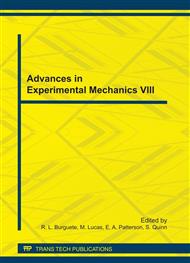[1]
European Committee for Standardization (CEN). Ref. No. prEN 1993-1-8: 2005 E – Eurocode3: Design of steel structures – Part 1-8: Design of joints (2005).
Google Scholar
[2]
P. Zoetemeijer: A design method for the tension side of statically loaded bolted beam-to-column connections. Heron: 20(1): 1-59 (1974).
Google Scholar
[3]
A.M. Girão: Characterization of the ductility of bolted end plate beam-to-column steel connections, PhD Thesis, Universidade de Coimbra (2004).
Google Scholar
[4]
V. Piluso, C. Faella and G. Rizzano: Ultimate behavior of bolted T-stubs. I- Theoretical Model, Journal of Structural Engineering, Volumen 127, no. 6, pag. 686-693 (2001).
DOI: 10.1061/(asce)0733-9445(2001)127:6(686)
Google Scholar
[5]
V. Piluso, C. Faella and G. Rizzano: Ultimate behavior of bolted T-stubs. II- Model validation, Journal of Structural Engineering, Volumen 127, no. 6, pag. 694-704 (2001).
DOI: 10.1061/(asce)0733-9445(2001)127:6(694)
Google Scholar
[6]
R. J. Greene, E. A. Patterson and R. E. Rowlands: Thermoelastic Stress Analysis, Chapter 26 from Springer Handbook of Experimental Solid Mechanics, Sharpe Editor (2008).
DOI: 10.1007/978-0-387-30877-7_26
Google Scholar
[7]
European Committee for Standardization (CEN). ISO 6892-1: 2009 – Metallic materials. Tensile testing – Part 1: Method of test at room temperature.
Google Scholar
[8]
European Committee for Standardization (CEN). ISO 377: 1997 – Steel and steel products. Location and preparation of samples and test pieces for mechanical testing.
DOI: 10.3403/01110284u
Google Scholar
[9]
ABAQUS Documentation (Version 6. 9. 2) Dassault Systèmes Simulia Corp., Providence, RI, USA, (2009).
Google Scholar
[10]
J.A. Swanson, D.S. Kokan and R.T. Leon: Advanced finite element modeling of bolted T-stub conncetion components. Journal of Construction Steel Research 58 (2002) 1015-1031.
DOI: 10.1016/s0143-974x(01)00098-0
Google Scholar
[11]
A.M.G. Coelho, L.S. da Silva, and F.S.K. Bijlaard. Finite element modeling of the Nonlinear behavior of bolted T-stub connections. Journal of Structural Engineering. 132 (2006) 918-928.
DOI: 10.1061/(asce)0733-9445(2006)132:6(918)
Google Scholar


